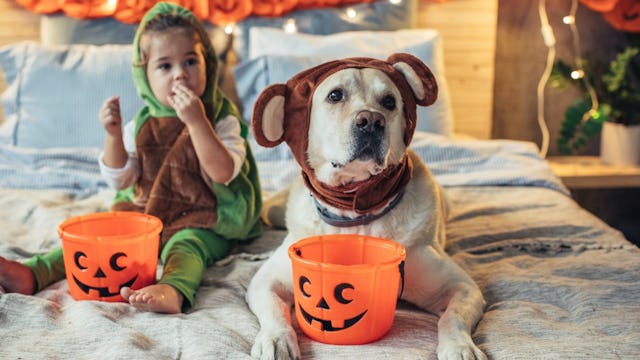5 Things To Consider Before Your Child Chooses A Halloween Costume

Halloween, more than any other holiday, is a gift to childhood. Sure, Christmas has a jolly man in a red suit who brings presents, and Easter promises an egg-wielding bunny with a basket of goodies, but Halloween is the stuff of childhood dreams.
It’s the one day of the year a kid can be anything they want. Whatever they imagine is possible; all their childhood idols and heroes are within reach. I loved Halloween as a child, but as a mom, seeing it through the eyes of my kids is even better. For one magical day, they live out fantasies of having built-in muscles, rocket ships, ruby slippers, or Olympic gold medals. Oh, and also: THERE’S CANDY!
RELATED: 16 Adorable Baby Halloween Costumes You Can Buy Online
Every year on Halloween, childhood wins.
But for all the captivating characters available as inspiration when choosing alter-egos, it’s easy for kids to go astray. They don’t always understand that some things are just plain mean, just plain wrong, just plain horrifying, or just a waste of the abundant creativity waiting to be harnessed.
With boundless opportunity, comes a wide margin for error, especially as our kids become old enough to choose and create costumes influenced by pop culture and current events. So before we send our costume-clad children out the door to school, or around the block to trick-or-treat, we might want to consider a few things:
1. Does a costume “mock” or make fun of a person or group of people?
If a costume plays into stereotypes and perpetuates negative thinking about a type of person or group of people (nerds, jocks, hobos, etc.), it may be an excellent opportunity to open up a dialogue about the damage of stereotypes and the importance of having acceptance and tolerance for differences
Need help starting the discussion? Try reading some of the many books available on being inclusive and accepting of others.
2. Does a costume use fashion or symbols from another culture?
If so, how? What is the reason for the cultural representation? Culturally influenced costumes are a tricky topic in general ― and become increasingly so when kids just want to dress as their favorite Disney character. It’s sometimes hard for parents to navigate between respectful dress-up and cultural appropriation. Even when it’s hard to know precisely where to draw the line, at the very least, culturally derived costumes can generate good discussions with our kids about diversity and how important it is to have respect for the historical experiences of cultures other than our own. A good rule of thumb: someone else’s culture is not a costume.
3. Is a costume unnecessarily sexy, skimpy, or tight-fitting just because it’s intended for a girl?
It’s never too early to teach girls to resist the idea that a costume must be sexually charged just because a female is wearing it. A quick Google search of “Girl Halloween Costume” produces pages and pages of sexy costumes for young girls that have no business being seductive. Clowns, angels, skeletons, scarecrows, and even crayons (seriously?!) become different versions of the same short, tight skirt and spaghetti-strapped top when any combination of “girl” and “Halloween” is entered into the search bar. Even Hermione Granger’s wizard robes have morphed into a pleated micro-skirt with thigh highs – obviously not conducive to assembling Dumbledore’s Army, brewing Polyjuice Potion, or freeing Ron and Harry from Devil’s Snare. (Duh!)
With an abundance of genuinely compelling female role models to choose from, Sexy-Blue-Crayon seems lackluster (not to mention, unnecessary). If you’re looking for inspiration, try these instead.
4. Does a costume fit the environment? (AKA: Read the room.)
Village mentality propels the species forward. It’s never too early for our kids to develop empathy or think of how their choices affect others. If they’ll be around small children on Halloween (siblings, family friends, cousins), it’s nice to consider how the younger ones might feel about a bloodthirsty zombie or ax-murderer. Is there a compromise? Is it possible to go without the mask or scary accessories when the Littles are around, but wear it later when trick-or-treating with like-minded peers? Knowing your audience is a life skill that will come in handy; might as well hone it early.
5. Is it divisive?
Is a costume political? Does it depict a current event or tragedy? If so, it’s probably going to bring about unnecessary controversy for the child wearing it. Leave the news headlines to the adults. (Or at least the older kids who might actually watch the news and have a better understanding of what they’re wearing and why.) Our kids will have plenty of time to explore the dos and don’ts of Halloween politics when they’re older and better prepared to defend and discuss their choices.
Hopefully, our kids will learn from us that Halloween is about the magic of becoming someone else – just not at anyone else’s expense (including their own).
This article was originally published on